
Article contents

The current average pension pot at 40 in the UK is £30,000. However, ideally you’d want a bit more to give yourself the retirement you deserve. Don’t worry if you haven’t got a big pension yet, the main thing about a pension is to consistently add to it, ideally monthly. We’ll show you how much you should be adding, and how best to save (it involves getting free cash).
Panicking a bit about how much you should have in your pension at 40? Relax, life begins at 40 right?
It’s probably a lot more than you might be expecting, but don’t worry, we’ll run through how best to boost your pension pot, and set yourself up for the retirement you deserve.
If you’re just here for a quick answer, the average pension pot at 40 in the UK is £30,000. Here's the breakdown for each age range:
Data: ONS (Pension wealth: wealth in Great Britain)
This bit is important. This is THE AVERAGE pension pot, and NOT THE RECOMMENDED pension pot.
The recommended pension pot is quite a lot bigger, but really, it all depends on how much you’d like each month in retirement (your retirement income). This of course varies from person to person (we’ll run through the 3 main income categories below), and then setting up your future monthly pension contributions to suit your retirement goals.
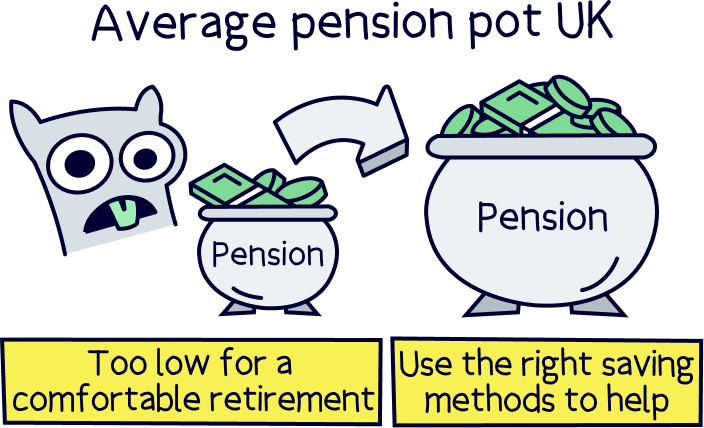
However, there is some good news: the State Pension (government pension). If you have a job and have paid enough National Insurance contributions over your lifetime (at least 10 years, but 35 years to get the full amount), you’ll qualify for the State Pension, which is £230.25 per week (£11,973 per year). You’ll get this at age 66.
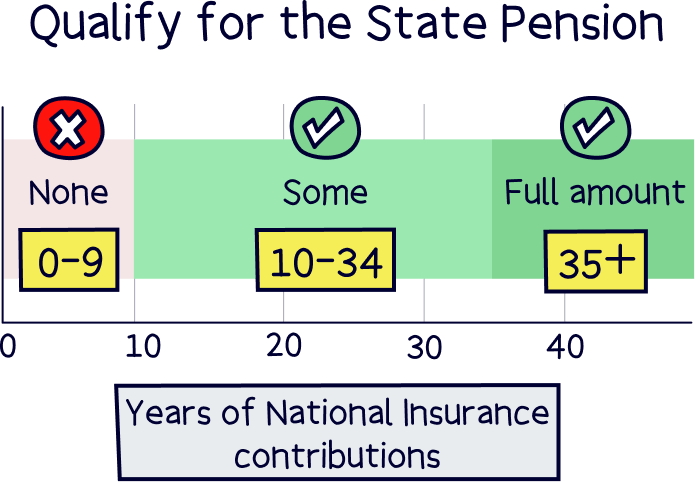
The bad news is you’ll likely not be able to live off this alone in retirement, it’s a lot less than minimum wage. You’ll need your own pension pot too.
PensionBee is our top rated provider, it’s easy to use and low cost – plus you’ll get £50 added to your pension when you open an account.
Here’s how much you’ll need to have in your own pension pot by the time you retire (for the 3 main retirement income levels).
Some huge numbers aren’t they? But don’t panic. At 40, it’s normal to have a lot less, there’s years left to save and benefit from compound interest…
Compound interest is where the money you make within your pension starts to make money too, and this snowballs over and overall, growing small amounts into very large amounts over long periods of time.
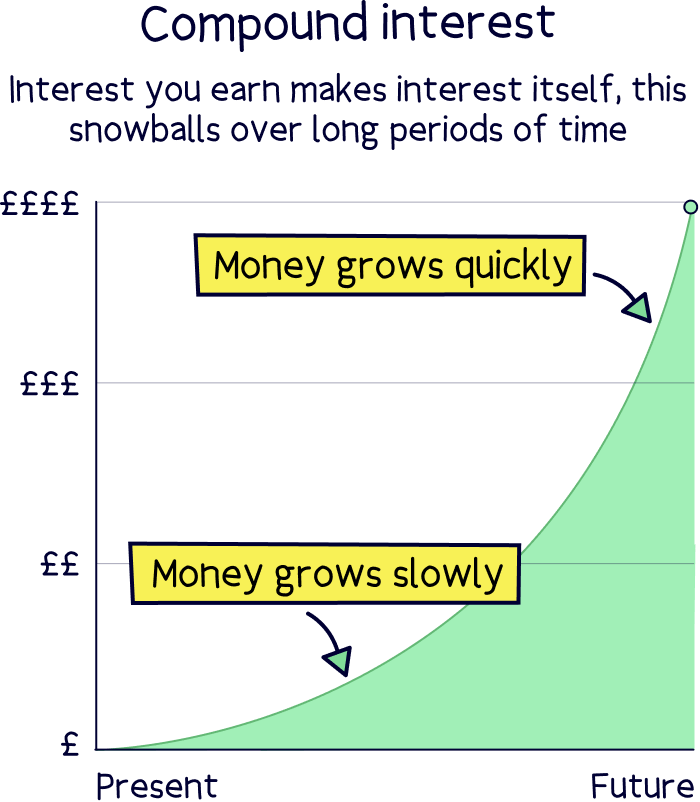
Building up your pension pot from now on is all down to saving regularly, and starting straight away if you’re not already. The sooner you save, the bigger it can grow.
We’ll cover all the details for how much you need to save per month to get the retirement you’re after, just below.
Before we get any further, let’s recap those 3 income levels we’ve mentioned. They’re the Retirement Living Standards, put together by the Pensions and Lifetime Savings Association.
They’ve determined how much you’l likely need in retirement, and broken it down into 3 main categories, a minimum level, moderate level and comfortable level.
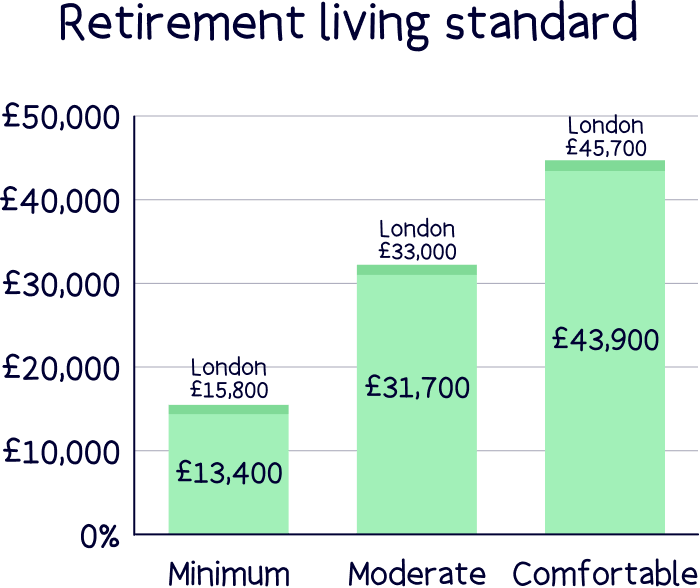
This is how much you’ll need to cover your basic needs in retirement. It’s £13,400 per year for one person, or £21,600 for a couple. You’ll have money for food, and clothes and a holiday in the UK but you won’t be able to afford a car.
In London, it’s £15,800 for one person and £24,800 for a couple.
This gives you a bit more flexibility and financial security, but it’s likely you might find it difficult. It’s £31,700 per year for one person, and £43,900 for a couple. There’s more for food, and you’ll be able to run a small old car, and one holiday in Europe per year.
In London it’s £33,000 for one person and £45,500 for a couple.
This gives you the freedom to do more things. It’s £43,900 per year for one person, and £60,600 for a couple. There’s even more for food and clothes, you’re able to run a 2 year old car, and afford a nicer holiday to Europe each year.
In London, it’s £45,700 for one person and £62,700 for a couple.
Right, let’s dive into how much you need to save per month to get those retirement standards (pension income). We’ll look at saving with the average pension pot at 40 (£30,000), a pension pot of £10,000, and if you haven’t started a pension yet.
Note: we’ve used a retirement age of 68, which is what the State Pension age is likely to be in future.
Don’t panic, it’s not quite all as it seems – these figures are how much you need to save into your pension pot(s) in total each month, but pensions are pretty amazing, and come with lots of free cash that can go towards these totals too. So, you don’t actually need to save the whole amount.
There’s two main types of pensions to save into, and they both come with free cash. A workplace pension (a pension your employer sets up for you), and a personal pension (a pension you set up yourself).
A workplace pension is what you’ll likely have if you’re employed, and is set up by your employer (called auto-enrolment). When you add 5% of your annual salary, your employer has to add at least 3% too (by law, called employer contributions). So, it’s 3% free cash, it's like a pay rise, paid straight into your pension pot.
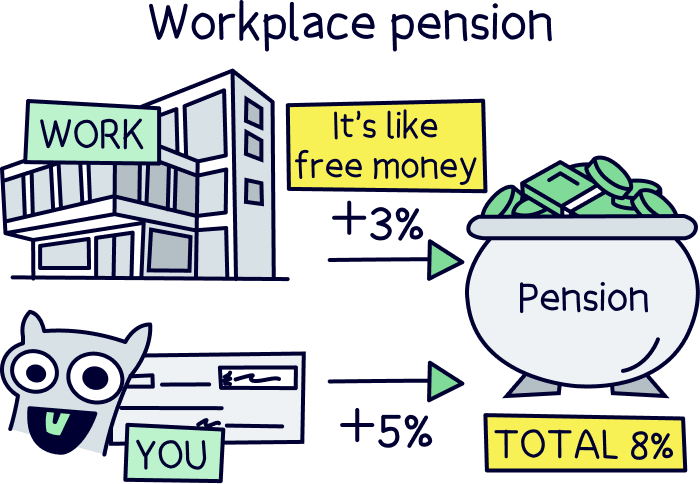
And some nice employers will pay even more into your pension if you contribute more too. So it’s even more free cash!
With a personal pension, which is a pension you set up by yourself (highly recommended in addition to a workplace pension), you’ll get a whopping 25% bonus from the government on everything you add. How great is that?!
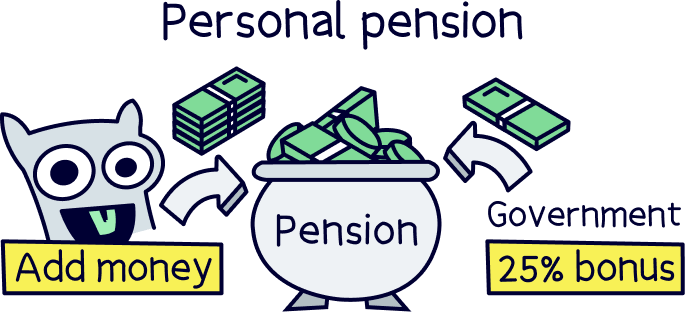
This is to refund the tax you’ve already paid on your income (e.g. on your annual salary), as pensions are intended to be tax-free. And it’s refunded straight into your personal pension pot (done automatically).
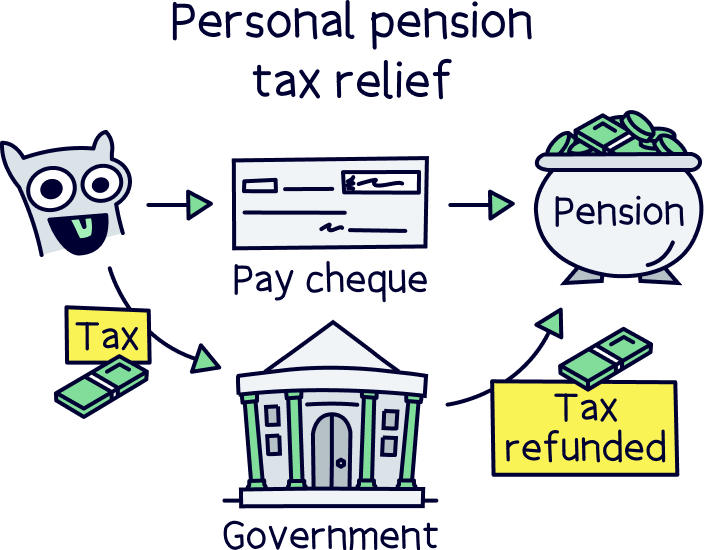
This also means that if you earn over £50,270 per year, you’ll be able to claim some of the tax you’ve paid at 40% (higher rate) or 45% (additional rate) too. (Which can be done on a Self Assessment tax return). If you want help, Taxfix¹ can help you, their service is rated 5 stars.
Plus, your money grows tax-free too.
We’ll cover personal pensions in more detail below, but they’re a brilliant way to increase your retirement savings.
If you’re keen to get started with one right now, we recommend PensionBee¹ – they’re 5* rated, easy to use and have low fees. You’ll also get £50 added to your account for free too when you register. For all the top options, check out our best pension providers.
Note: if you’re self-employed, this is your only option to save into a pension, but a great one! Learn more with our guide to self-employed pensions.
Free cash, and a lot of it (25%), can make up a big chunk of your monthly pension contributions. Let’s run through an example.
Let’s say you earned £3,000 from your job each month. If you were saving 5% of your salary into your workplace pension, that would be £150 per month. That would also mean your employer has to pay in at least 3% too, which is a free £90 per month.
That’s a total of £240 per month, which covers the minimum retirement income (plus a bit more).
If you’re able to save more, and pay into a personal pension as well, a monthly payment of £100 per month would mean a free £25, paid straight into your pension pot.
So, from paying £250 per month into your pension, you’ll actually end up with a massive £365 going in every month. That’s an extra 45% of your contributions all for free!
If you save even more each month, you’ll get even more free cash! You can see how pensions are pretty amazing, and those monthly totals above, aren’t all quite as impossible as they first seemed right?
The key is saving regularly, and as much as you can comfortably afford, you’ll benefit from loads of free cash, and your pension pot growing over time too.
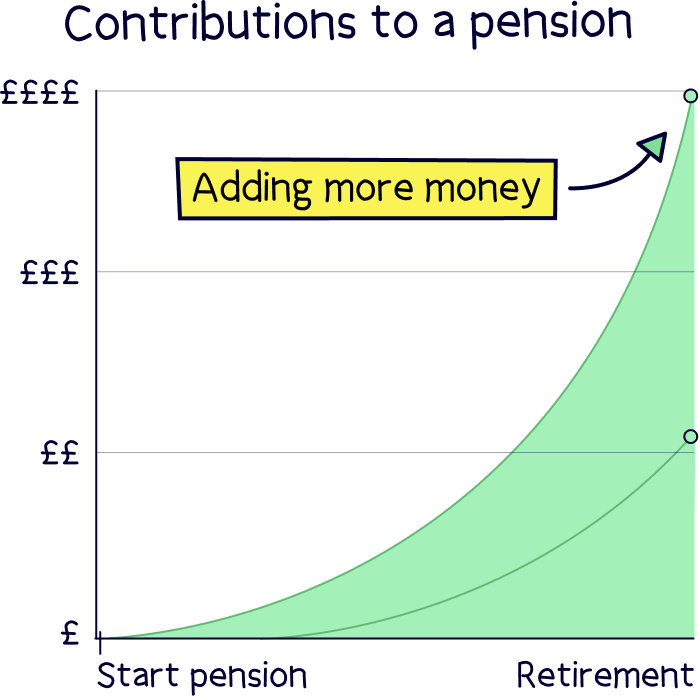
Nuts About Money tip: if you’re keen to get a more personalised amount figure for how much you need to save, check out PensionBee’s pension calculator. Be sure to come back here to get a free £50 bonus if you sign up to PensionBee¹ through Nuts About Money.
There’s an old general rule of thumb for working out how much you should have in your pension at 40, and it’s very old fashioned, so we’re not recommending it, but it’s good to know.
You should have 1.5x your current annual salary in your pension pot by age 40.
So, as an example, if you’re earning £30,000 per year, you should have £45,000 in your pension pot at 40.
Here’s a few other options:
We say it’s not really worth thinking about, as these days, our working lives change a lot more rapidly than they did previously. You could have a completely different job, earning a completely different salary in a couple of years time (either bigger or smaller), and then again two years after that, so it’s really not worth considering anything based on your current salary.
It’s a far better idea to have a look at the retirement incomes we’ve shared above, decide what you might be happy with when you retire, and then aim to build a pension pot to suit that. Don’t stress about what your pension pot should be now.
Plan how much you need to start saving each month to build up your pension pot to give yourself the best retirement possible.
Let’s get to the super helpful stuff, how to actually boost your pension pot.
If you’ve got a very nice employer who contributes more into your pension (than the minimum 3% if you pay more in 5%), for instance, if you add 10%, they’ll also add 10%, you should take them up ASAP. It’s even more free cash!
If they don’t (and not many do), then the best option (and still a brilliant option) is to open a personal pension and pay into that each month instead.
As mentioned, but it's worth mentioning again, with a personal pension, you’ll get a massive 25% bonus on everything you add. You get to decide which pension provider to use, so you can pick one that’s easy to use, has low fees and a great track record of growing pensions over time.
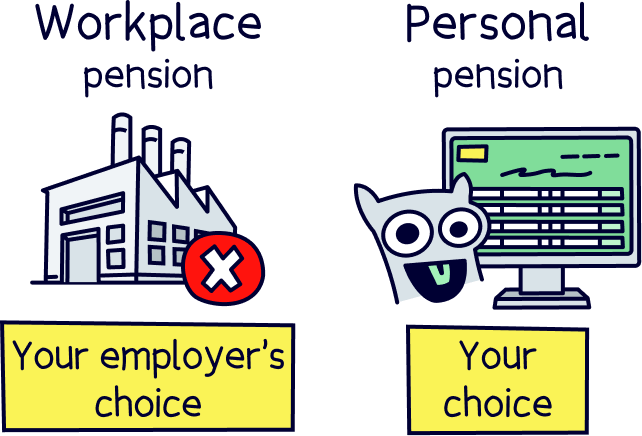
We recommend personal pensions because sometimes, a workplace pension scheme can be a bit like being stuck on a bad mobile phone contract, with very low data and minutes, but paying over the odds, and not being able to switch. A personal pension gives you the option to pick the best phone contract out there (and switch whenever you like).
Our top recommendation is PensionBee¹, for all of those reasons (you’ll even get £50 added to your pension when you register too). For all the top options, check out the best personal pensions.
You can also move any old pensions over too (called consolidating your pension), for instance any old pensions from old jobs. This way you won’t forget about them (a lot of people do), and could mean you’ll pay lower fees overall, not only do some of the best personal pensions have lower fees to start with, but the fees reduce the more you have saved with them.
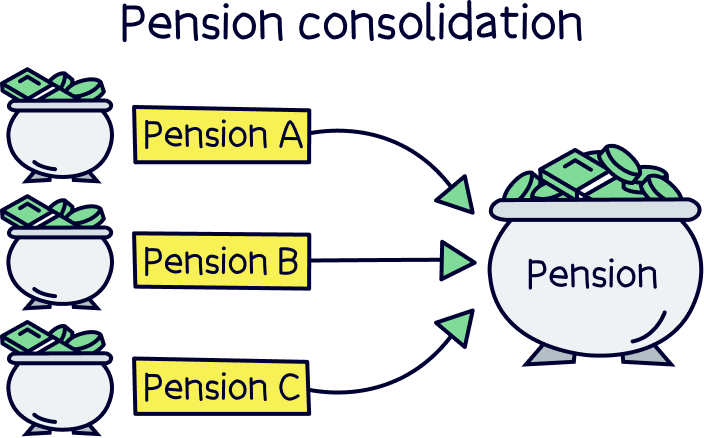
It also means your money could grow much more over time (as the fees aren’t reducing your money as much each year), and with better investment options too.
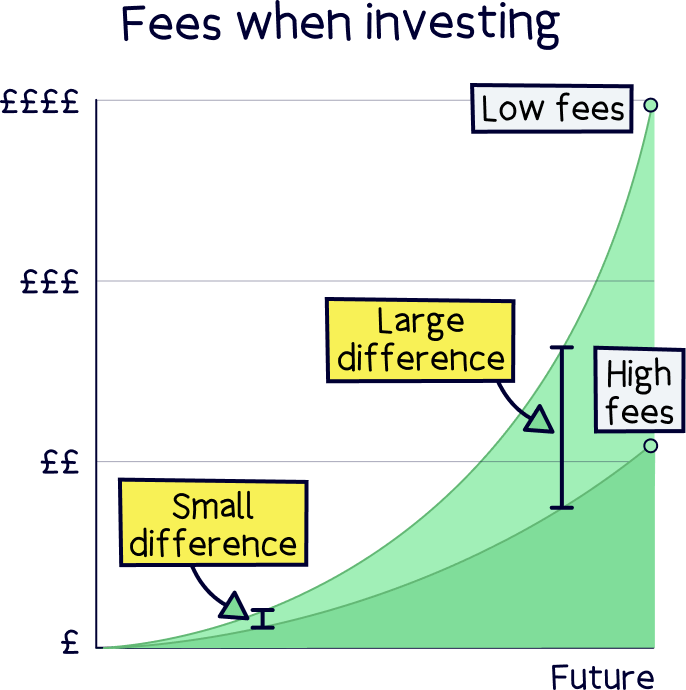
Once you’re set up with a personal pension (it’s super easy), all that’s left to do is to consistently contribute as much as you comfortably can (without overstretching yourself), and watch your pension pot grow over time!
Ready to get started with a personal pension? Here’s our top picks.
Get £50 added to your pension



PensionBee is our recommended provider – they’ve thought of everything.
Their 5 star rated app (and website) makes it easy to set up and use. You can open a brand new pension, or transfer your existing pensions across (they’ll handle all the paperwork).
Simply pick from an easy to understand range of pension plans, and that’s it, the experts manage everything from there.
It’s low cost, with one simple annual fee. The customer service is excellent, and you’ll get a dedicated account manager for any questions you might have.

And, when the time comes to retire, withdrawing from your pension is easy too.
You can also use them if you're self-employed or a company director.
Great app



A great and easy to use pension. Add money from your bank or combine old pensions into one, (they’ll find lost pensions too).
The customer service is excellent, with support based in the UK.

Beach is an easy to use pension app (and easy to set up), where you just add money and the experts handle everything. It’s all managed on your phone with a great app, and you can see your total pension pot whenever you like.
If you’ve got lost or old pensions, Beach can also find them and move them over too, so you can keep all your retirement savings in one place, and never have to worry about losing them in future.
You’ll get an automatic 25% bonus on the money you add to your pension pot from your bank account (tax relief from the government), which refunds 20% tax on your income, and if you pay 40% or 45% tax, you’ll typically be able to claim the extra back too.
The pension plan (investments) are managed by experts, who are the largest investment company in the world (BlackRock). And they consider things like reducing climate change, meaning your savings could make the world a little better in future too.
You can also save and invest alongside your pension with an easy access pot (access money in around a week), designed for general savings, with the investments managed sensibly by experts too. And money made can be tax-free within an ISA.
Fees: a simple annual fee of up to 0.73% (minimum £3.99 per month).
Minimum deposit: £25
Customer service: excellent
Pros:
Cons:
PensionBee is our top rated provider, it’s easy to use and low cost – plus you’ll get £50 added to your pension when you open an account.
Find local financial advisors near you.



Unbiased is a great online service to help you find expert financial advisors who can help with your pension.
It’s very popular, with over 10 million customers, and pretty much the go-to-place to find pension advisors local to you.
All advisors are fully vetted, qualified and have years of experience.
You’ll be able to chat on the phone, video call, or visit in person (depending on the advisor).

It’s free to use the service, you’ll pay the advisor directly if you choose to use them (fees vary per advisor and service you’d like).
PensionBee is our top rated provider, it’s easy to use and low cost – plus you’ll get £50 added to your pension when you open an account.
Pensions are confusing, with lots of different names, but just to make sure we’re all on the same page. A private pension is any pension that’s not the State Pension (the government pension).
So, a workplace pension (set up by your employer) and a personal pension (set up by you) are both types of private pensions.
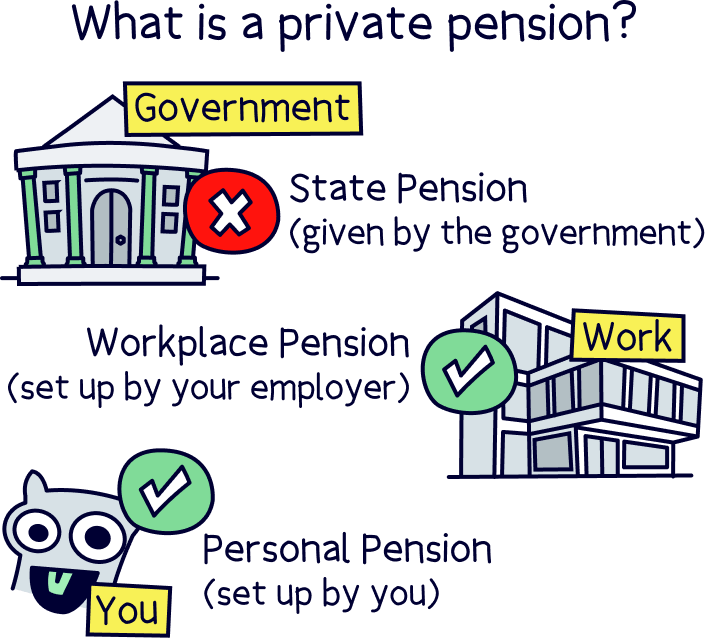
Let’s dive into the details a bit more about personal pensions, as they’re pretty great, and you’ll likely want one to help boost your pension pot.
As we’ve mentioned, there’s free money! Everytime you save into a personal pension, you’ll get a massive 25% bonus from the government – immediately boosting your pension pot by a lot!
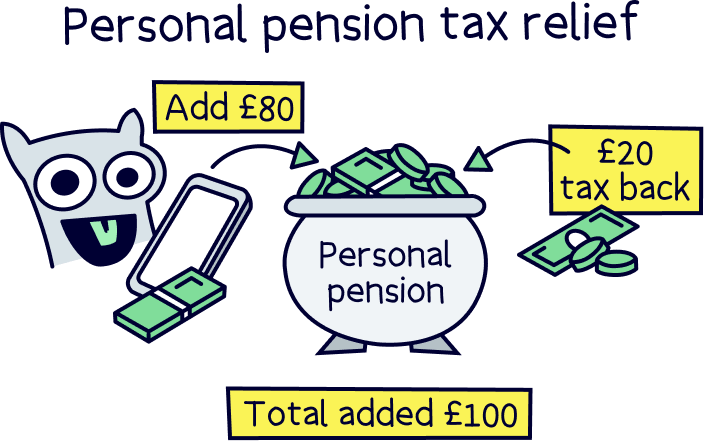
You’ll also be able to claim back some tax you’ve paid at either 40% (earning over £50,270 per year, called higher rate tax), or 45% (earning over £125,140, called additional rate tax). If you’ve paid those amounts of course. You can do this on a Self Assessment tax return.
And as your money grows, you won’t pay any tax – meaning it can grow much faster over time.
You can save up to your whole annual income (e.g. your salary), or £60,000 per tax year, whichever is lower. A tax year runs from April 6th to April 5th the following year. This applies to all your pension pots in total.
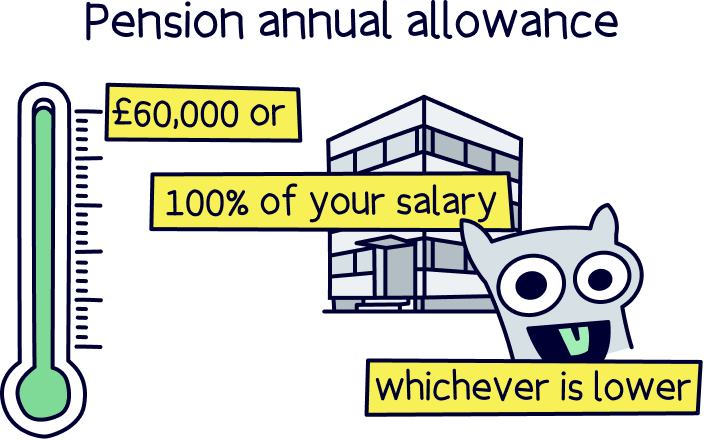
You won’t be able to withdraw your money until you’re at least 55 years old (rising to 57 from 2028). Remember, it’s for retirement!
When it does come time to withdraw your money, the first 25% will be completely tax-free. With the remaining 75%, you might pay tax on it, which will be Income Tax (the same tax as your salary now).
Here’s where it gets even more complicated, there’s two types of personal pensions, an expert-managed personal pension and a self-invested personal pension (SIPP).
This is where the experts manage pretty much everything. How great! All you need to do is register, add money and pick from a simple range of pension plans.
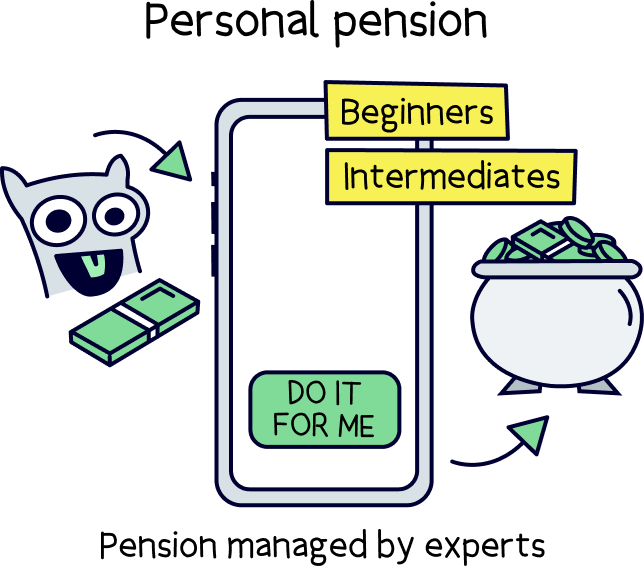
After that, the experts will handle the pension investments and use sensible investment strategies to grow your money over time (if you've chosen a good one).
There’s normally experts on hand to help with any questions you might have too.
We recommend this option for almost everybody, and our recommended option is PensionBee¹ (it’s super easy to use).
A self-invested personal pension (SIPP) is where you make all the investment decisions (rather than the experts).
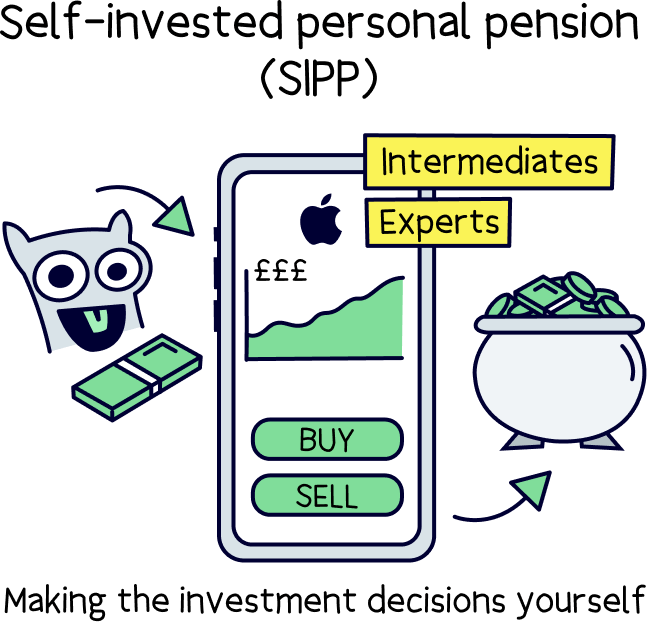
You’ll still get all the great benefits of a personal pension (the pension tax relief), such as tax-free investment growth, and the 25% bonus.
However, you can invest in a huge range of options (depending on the pension provider), which can include stocks and shares (where you own a part of a company, a share of a company), and investment funds, which are a group of investments all pooled together into a single investment, managed by experts (a popular option). Investment funds designed for pensions are often called pension funds.
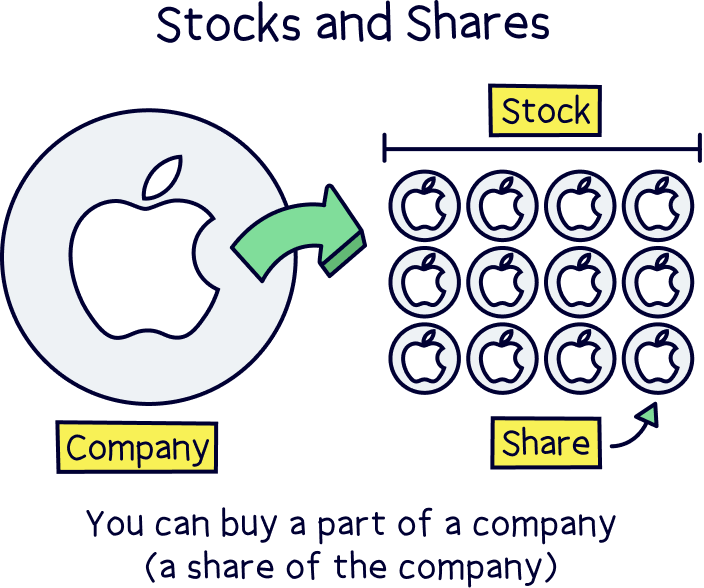
If this sounds interesting, here’s our guide to the best SIPP providers.
Note: often modern expert-managed personal pensions are technically SIPPs too – they simply provide a very small range of pension plans (pension funds), that you can pick from. They’re pretty great, and still managed by experts.
Saving into a personal pension is very safe. All pension providers need to be approved and authorised by the Financial Conduct Authority (FCA). They’re the people who make sure financial companies, like pension providers, are looking after you and your money.
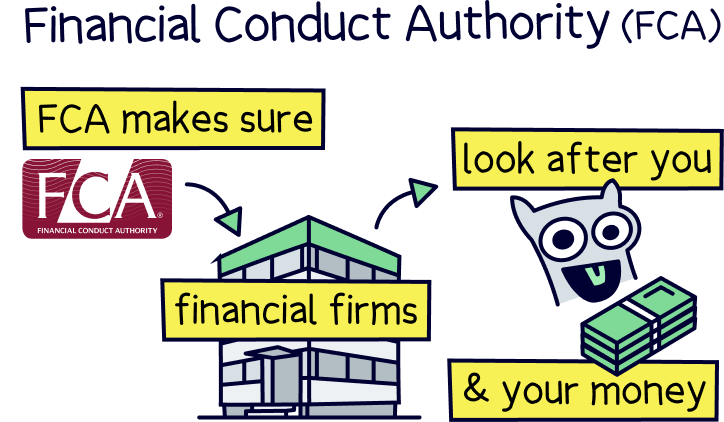
If you’re not sure about a pension provider, check the FCA register to see if they’ve been authorised.
This also means that your money is covered by the Financial Services Compensation Scheme (FSCS). This is where you could get up to £85,000 in compensation (and sometimes 100% for pensions), if your pension provider goes out of business.
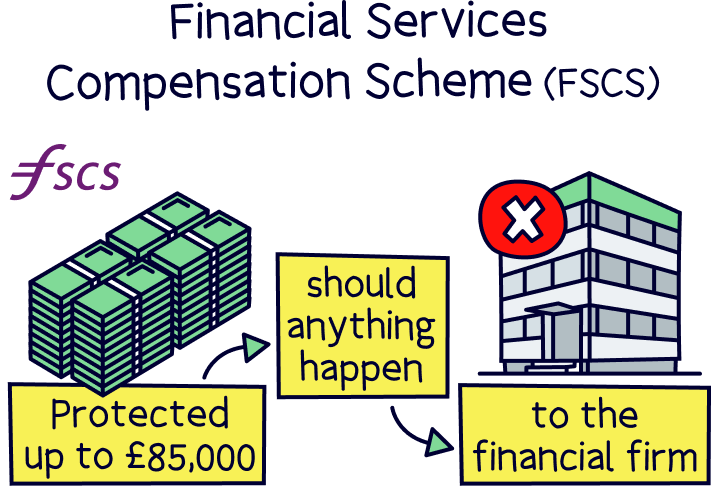
However, your money is typically held in the investments themselves, which are with large investment companies and banks, all held in your name, and can only be returned to you.
As your money is invested, that doesn’t mean your money can’t go down in value (as well as up). However, typically when investing sensibly over the long-term, pensions tend to increase significantly, but there will always be ups and downs along the way.
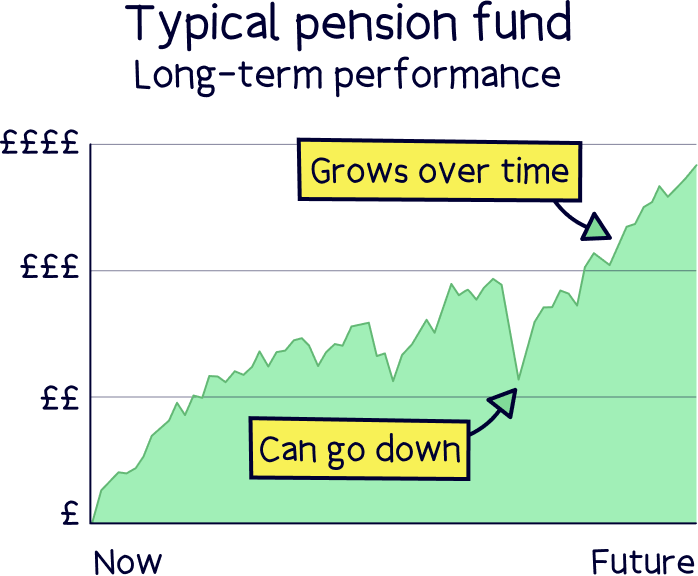
That’s it for your pension pot at 40, and saving for retirement. All make sense? Hopefully it does, and don't stress (yet), if you haven’t much money in your pension pot. There’s still loads of time to build the retirement you deserve.
It all comes down to how much you can save per month from now on – and start as soon as you can! There’s lots of free cash available when it comes to pensions, and it all adds up, you’ll be surprised how much your pension can grow over time.
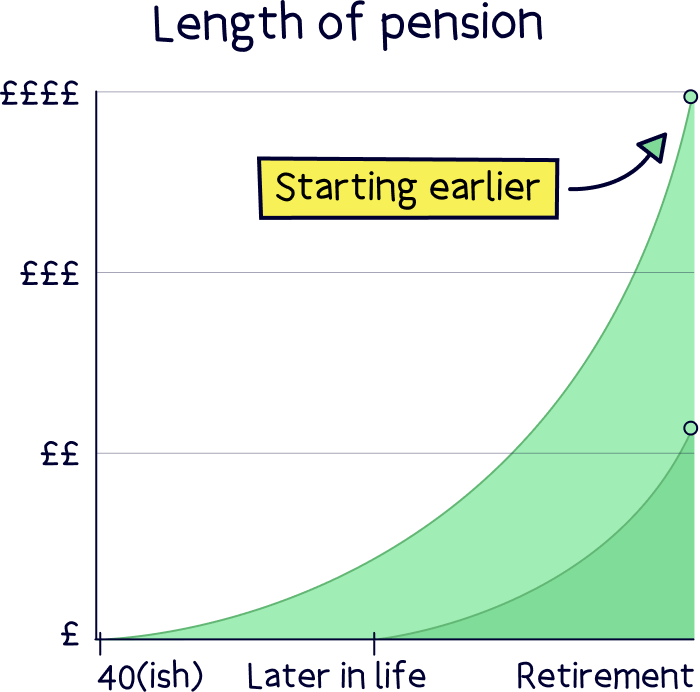
Now let’s recap on how much you’ll want to save for the 3 retirement income levels (minimum, moderate and comfortable). These figures include receiving the full State Pension too, and a current pension pot of £30,000.
For the minimum, £13,400 per year in retirement, and a pension pot of £88,958, your monthly contributions should be £70.
For a moderate retirement income of £31,700, and a pension pot of £564,615, you’ll want to aim for a total monthly pension contribution of £1,320.
And for a comfortable retirement income of 43,900 per year, you’ll want a pension pot of £881,719, and total monthly contributions of £2,150.
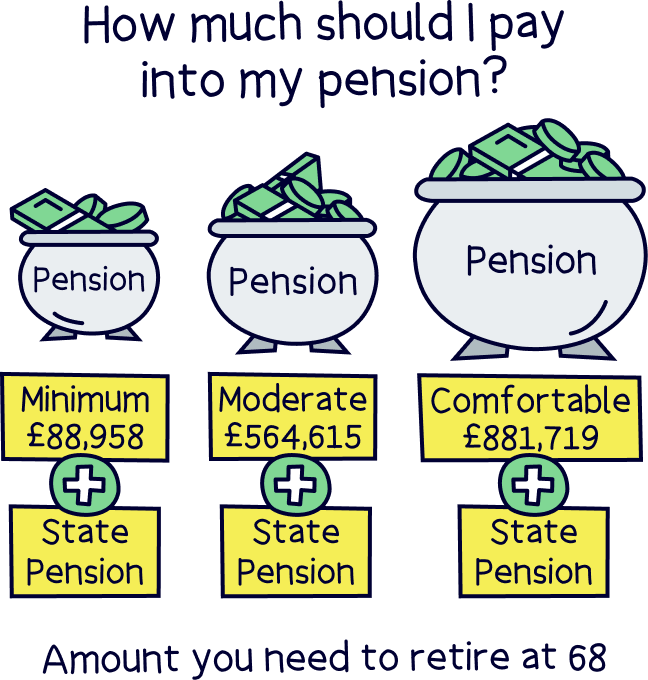
These are fairly hefty figures, but the important thing is not to panic – the bonuses will help, and try to put away as much as you can comfortably afford each month, it will soon add up, and there’s still lots of time for it to grow.
The best way to save is first, check if your employer will add any more cash into your workplace pension if you add more (some employers do, most unfortunately don’t).
Then, set up a personal pension and start saving into it monthly (if you can), this way you’ll automatically get a massive 25% bonus on everything you save, and the money can grow tax-free too. With everything handled by experts who know how to make money grow.
It’s important to pick a pension provider that’s easy to use, has low fees and a great track record of growing pensions over time.
Our top recommendation for that is PensionBee¹ (and you’ll get £50 added to your pension for free). There’s also Beach¹, which is great too, and offers a pension and ISA (for everyday savings) at the same time, or check out the full range of the best personal pensions (UK).
If you’re still a bit unsure and need some more advice, speak to a financial advisor, they’ll be able to look at your individual circumstances and support with retirement planning. Here’s our guide to financial advisors to learn more.
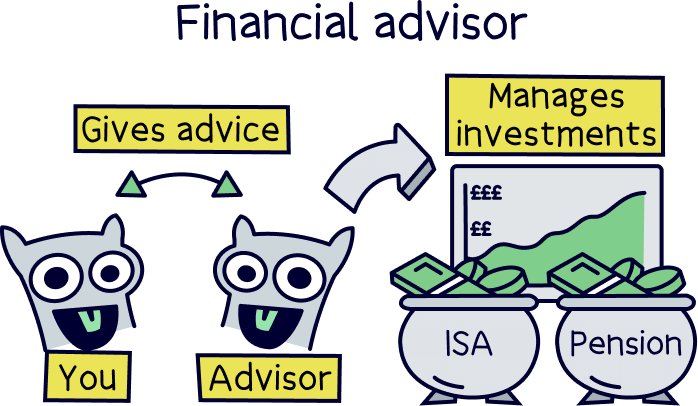
All that’s left to say is all the best with your pension savings, and enjoy retirement in future!
PensionBee is our top rated provider, it’s easy to use and low cost – plus you’ll get £50 added to your pension when you open an account.
We’d love to hear from you, and it will help others too.
PensionBee is our top rated provider, it’s easy to use and low cost – plus you’ll get £50 added to your pension when you open an account.